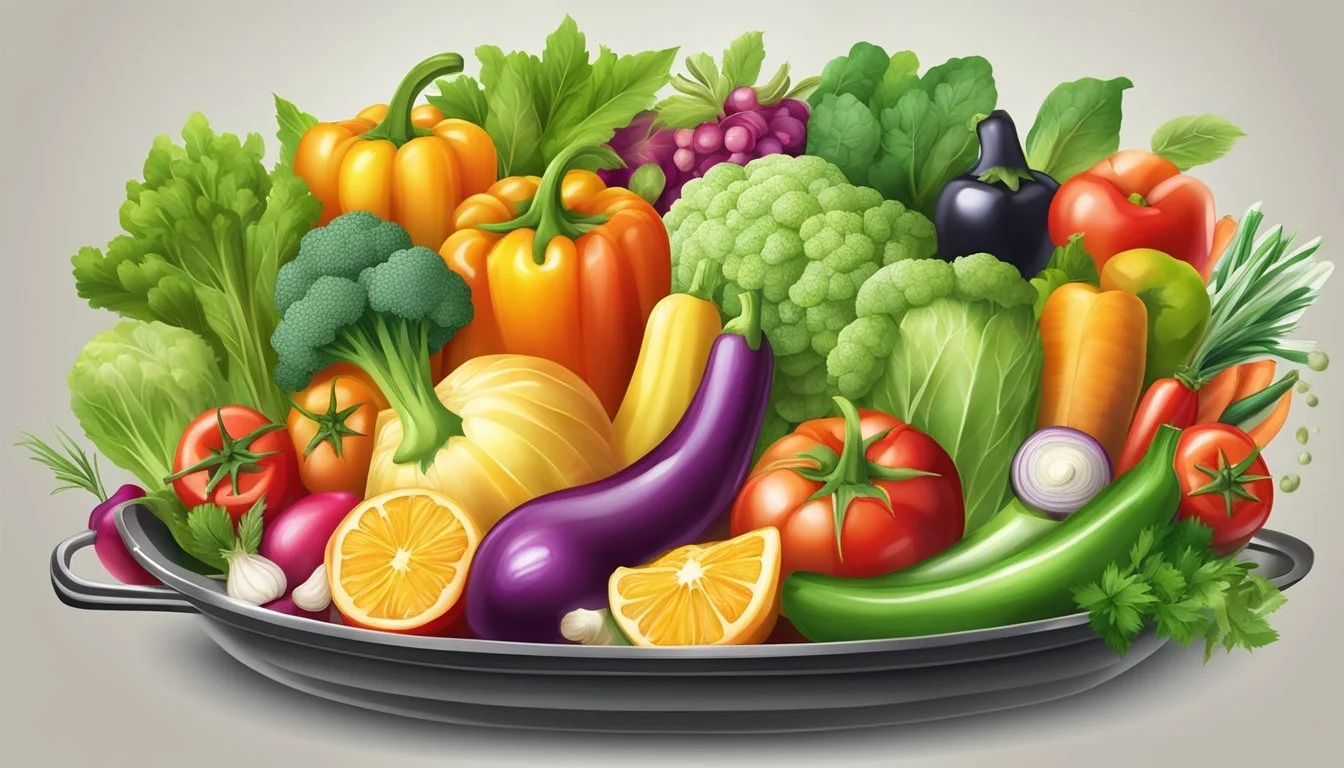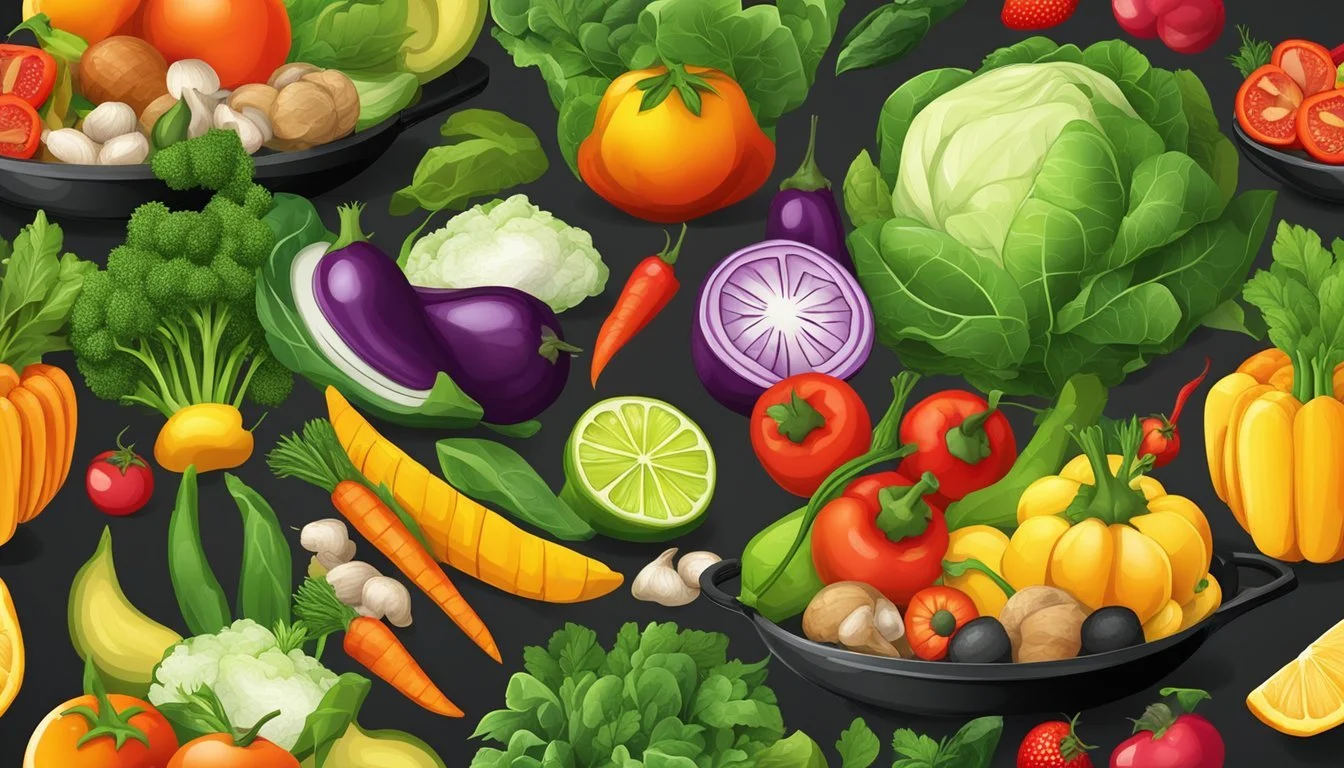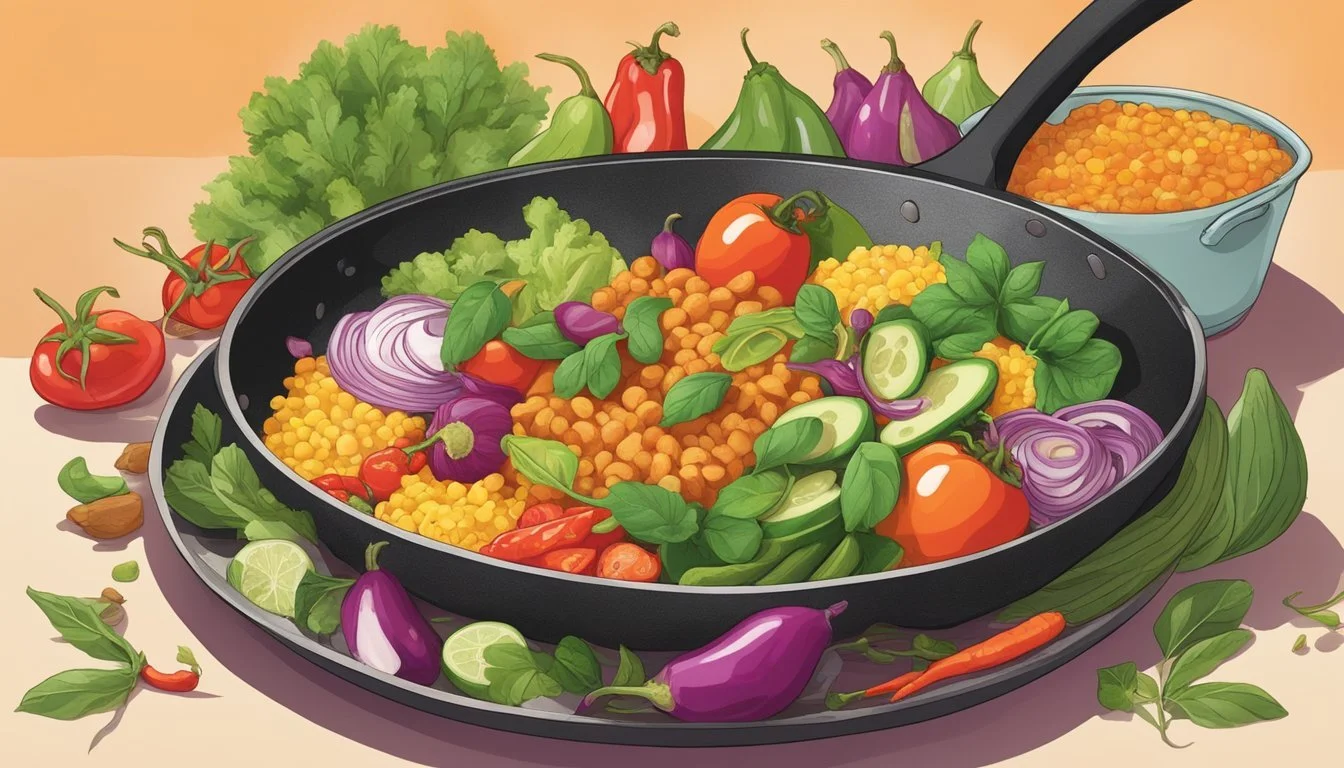Swicy in Vegan Cuisine
Exploring the Fusion of Sweet and Spicy Plant-Based Flavors
The culinary world is constantly evolving, with innovative flavors and trends emerging to delight the palate and inspire new dishes. One such trend that has permeated both traditional and plant-based cuisine is the "swicy" phenomenon—combining sweet and spicy elements to create a complex and satisfying taste. In vegan cuisine, this fusion has been embraced with enthusiasm, unlocking a realm of plant-based sweet-spicy delights that cater to a variety of tastes and preferences.
Swicy flavors in vegan dishes offer a dance of contrasting but complementary tastes, enhancing the natural flavors of vegetables, grains, and legumes. Vegan cooking, which excludes animal products, presents a canvas for sweet and spicy ingredients to shine, such as the use of maple syrup to add sweetness or the inclusion of chili peppers for a spicy kick. This combination is not only about taste but also about balance. Swicy dishes incorporate the sweetness to mellow the heat, allowing for a broader appeal, especially for those who may be more sensitive to spice.
Plant-based eaters, from the seasoned vegan to the curious omnivore, are finding that swicy flavors bring a refreshing and exciting twist to their meals. Whether it's through a tangy and fiery barbecue sauce draped over grilled tempeh (What wine goes well with tempeh?) or a subtly sweet and peppery glaze on roasted vegetables, (What wine goes well with roasted vegetables?) swicy vegan creations are staking their claim in the ever-growing world of plant-based cuisine. These flavors are not just a fleeting trend but a testament to the creativity and versatility that vegan cooking offers to those seeking culinary exploration without animal products.
Fundamentals of Vegan Cuisine
Vegan cuisine encompasses dishes that are made without the use of animal products, focusing on plant-based ingredients to create flavorful, nutritious meals. This section will explore what defines vegan and plant-based eating, as well as the nutritional considerations vital to a vegan diet.
Defining Vegan and Plant-Based
Vegan diets strictly exclude meat, dairy, eggs, and any other products derived from animals. The term plant-based often refers to a diet centered on whole, unprocessed plant foods but may sometimes include minimal animal products. Both diets emphasize the consumption of vegetables, fruits, grains, legumes, nuts, and seeds.
Nutritional Considerations in Vegan Diet
A balanced vegan diet should provide all the necessary nutrients to maintain health. Key nutritional elements include:
Protein: Essential for tissue repair and muscle growth. Beans, lentils, chickpeas, and soy products such as tofu are excellent sources of vegan protein.
Fiber: Important for digestive health. Whole grains, vegetables, and fruits are high in fiber.
Vitamins A and C: Critical for immune function and skin health. Dark leafy greens and orange-colored vegetables are rich in vitamin A, while fruits like oranges and strawberries are high in vitamin C.
Calcium and Iron: Vital for bone health and oxygen transport, respectively. Calcium can be derived from fortified plant milks and leafy greens; iron is found in legumes, tofu, and fortified cereals.
Potassium: Helps regulate fluid balance and nerve signals. Bananas, potatoes, and avocados are high-potassium foods.
To ensure a well-rounded vegan diet, individuals should consider variety and nutrient-dense foods while planning meals to cover all nutritional bases.
Essentials of Sweet-Spicy Flavors
Exploring the dynamic world of sweet-spicy flavors in vegan cuisine reveals an intricate dance between the heat of spices and the soothing presence of natural sweeteners.
Balancing Sweetness and Heat
In plant-based cooking, achieving a harmonious balance between sweet and spicy elements is paramount. Sweetness often comes from natural sweeteners like maple syrup, agave nectar, and even honey (for those who include it in their diet). These not only add flavor but can also temper the boldness of spices. Heat, on the other hand, is introduced through garlic, ginger, or more direct sources like chili peppers. The use of soy sauce and tamari (gluten-free option) reinforces umami and saltiness, which can further enhance or moderate spicy notes. The key is to start with a smaller amount of spicy ingredients and adjust upwards to taste, ensuring that no flavor overpowers another.
Signature Ingredients for Sweet-Spicy Profiles
Creating memorable sweet-spicy profiles in vegan dishes often involves a suite of specific ingredients. Here's a table highlighting several key components:
Sweet Components Spicy Components Maple Syrup Chili Peppers Agave Nectar Garlic Honey (non-vegan option) Ginger Fresh or Dried Chilies
For depth and texture, sesame seeds can be added, often toasted to release their nutty richness. Toasted sesame seeds bring an additional layer of complexity to any sweet-spicy mix. Rice vinegar brings a tangy aspect that can play well with sweet syrups, brightening the dish's overall profile. To thicken sauces, cornstarch serves as an essential ingredient, creating a silky sheen and smooth mouthfeel. Whether as a dressing or a stir-fry sauce, the interplay of these ingredients forms the backbone of many iconic vegan sweet-spicy dishes (What wine goes well with spicy dishes?).
Vegan Sweet-Spicy Recipe Ideas
Vegan cuisine doesn't shy away from bold flavors. This section explores plant-based recipes that masterfully combine sweetness with a spicy kick, perfect for any course.
Appetizers and Starters
Sweet and Spicy Tofu Bites: A crowd-pleasing appetizer, these tofu bites are glazed with a mixture of brown sugar, sesame oil, and tamari, then browned to perfection. The balance of sweet and spicy flavors provides a satisfying start to any meal.
Asian Tempeh Lettuce Wraps: Marinate tempeh in a sweet-spicy sauce with Asian influences, then wrap it in crisp lettuce leaves. Garnish with finely chopped bell peppers and a drizzle of extra sauce for a burst of flavor.
Side Dishes
Spicy Avocado and Bell Pepper Salad: Create a refreshing side dish by combining ripe avocado with thinly sliced red and yellow bell peppers. Tossed in a dressing with a hint of sweetness and a spicy edge, this salad is the perfect complement to any meal.
Sesame Cabbage Stir-Fry: Quickly stir-fried cabbage gets a sweet-spicy upgrade with a blend of brown sugar and hot peppers. A dash of sesame oil brings a nutty aroma to this simple yet tasty side.
Weeknight Dinners
Spicy Vegan Laksa: The rich coconut milk base, infused with homemade sambal and curry powder, turns into a hearty noodle soup loaded with vegetables like eggplant and bean sprouts—ideal for a comforting dinner.
Stuffed Bell Peppers (What wine goes well with stuffed bell peppers?): Bell peppers (What wine goes well with bell peppers?) filled with a sweet-spicy mixture of onions, grains, spices, and topped with a savory glaze make for an easy and satisfying weeknight dinner. They're as nutritious as they are flavorful.
Special Considerations for Dietary Needs
Crafting a Swicy dish within vegan cuisine requires careful consideration of the dietary needs of individuals with specific restrictions, ensuring that each meal is both satiating and in alignment with their nutritional requirements.
Gluten-Free Vegan Options
Gluten-free vegan diners have a variety of plant-based ingredients at their disposal for Swicy dishes. Key ingredients such as chickpeas provide both protein and fiber, making them a staple for anyone avoiding gluten. Swicy sauces can be thickened with arrowroot or cornstarch instead of wheat flour, ensuring that individuals with gluten sensitivities can still enjoy the balance of sweetness and heat without concern.
Chickpeas: Fiber (12.5g per cup), Protein (14.5g per cup)
Arrowroot: Gluten-free thickener
High-Protein Vegan Choices
High-protein vegan meals are essential for maintaining muscle health and overall well-being. Legumes like kidney beans pack a protein punch and can be incorporated into Swicy dishes alongside a side of quinoa for an additional protein boost. Fermented soy products, such as tempeh, provide not only a rich source of protein but also offer the benefits of prebiotics and a satisfying texture.
Kidney Beans: Protein (15g per cup)
Quinoa: Protein (8g per cup), complete amino acid profile
Tempeh: Protein (20g per cup), fermented, contains prebiotics
Low-Calorie Vegan Meals
Designing Swicy vegan meals with a low-calorie count demands the selection of vegetables high in nutrients yet low in calories. Cauliflower, spiraled zucchini, and leafy greens are excellent bases for these dishes, providing volume and fiber content with minimal caloric impact. Dishes can be flavored with fresh herbs and spices rather than calorie-dense sauces for an abundance of taste without the excessive calories.
Cauliflower: Calories (27 per 100g), versatile in cooking
Zucchini Noodles: Calories (20 per cup), substitute for pasta
Leafy Greens: Low in calories, high in fiber
By integrating these considerations into Swicy vegan dishes, diners with specific dietary needs can enjoy each meal with confidence in its nutritional suitability.
Creating Sweet-Spicy Concoctions at Home
In the landscape of vegan cuisine, creating sweet and spicy flavors at home can transform plant-based dishes into tantalizing experiences. Mastering homemade marinades and glazes as well as customizing vegan meals allows for endless creativity.
Homemade Marinades and Glazes
Creating homemade marinades and glazes can bring a bold swicy character to vegan dishes. For a sweet-spicy marinade, one might start with a base of roasted garlic puree, adding grated ginger for a warm spice and a hint of maple syrup for sweetness. The marinade can be gently simmered to meld the flavors together. A touch of sea salt balances the sweetness, while ingredients like crispy tofu or roasted chickpeas can be tossed in these marinades and then baked to achieve a sticky, caramelized exterior.
Ingredient Purpose Roasted Garlic Depth of flavor Grated Ginger Warm spice Maple Syrup Sweetness Sea Salt Flavor balance
Customizable Vegan Meals
Creating customizable vegan meals centers on the selection of base ingredients that cater to personal preferences. A satisfying bowl could start with crunchy greens such as kale, spinach, arugula, or bok choy, then topped with a swicy glazed protein like the aforementioned crispy tofu. For additional texture and nutrition, roasted chickpeas add a protein-packed crunch. The beauty lies in the versatility of these dishes, easily adapted to include whatever vegetables and proteins are on hand.
Customizable Vegan Bowl Components:
Base: kale, spinach, arugula, bok choy
Protein: crispy tofu, roasted chickpeas
Dressings/Glazes: sweet-spicy marinades, dairy-free dressings
In summary, one's kitchen can serve as a canvas for swicy vegan creations, with homemade marinades infusing sweet and spicy notes and customizable meals offering a personalized dining experience.
International Inspirations
Plant-based cuisine often takes inspiration from international flavors, combining the sweetness and heat that appeal to a broad range of palates. In particular, Asian and Mediterranean cuisines provide a rich tapestry of tastes that can be incorporated into vegan dishes to create "swicy" (sweet and spicy) sensations.
Asian-Inspired Vegan Cuisine
Asian cuisine offers a diverse palette of flavors, with its embrace of toasted sesame oil and bold spices. In the realm of plant-based Asian dishes, toasted sesame oil provides a distinctive nutty taste, often used as the foundation for sauces and dressings. A "swicy" creation might include a Szechuan dish, where the incorporation of peppers and sweeteners results in a complex, layered culinary experience. Gut health can also be considered through the use of fermented products like kimchi, which adds both heat and probiotic benefits.
Key ingredients in Asian-Inspired Vegan Cuisine:
Toasted Sesame Oil: Adds a rich, deep flavor to dishes.
Chilies: Provides the heat component of "swicy".
Mediterranean-Inspired Vegan Dishes
The Mediterranean palette offers its own unique spin on "swicy" with ingredients like harissa—a hot chili pepper paste that combines sweetness with earthy spices. Harissa can be used in a variety of vegan dishes, from grain bowls to roasted vegetables. Mediterranean-inspired dishes also often feature herbs like thyme, which add a subtle layer of complexity to the flavor profile. The balance of sweet and spicy elements in these dishes can be tailored to individual tastes, while also providing a medley of benefits from a diet rich in plant-based ingredients.
Key ingredients in Mediterranean-Inspired Vegan Dishes:
Harissa: The centerpiece for many "swicy" dishes, offering a tangy, fiery kick.
Thyme: Complements with its aromatic, earthy notes.
By integrating Asian and Mediterranean influences into vegan dishes, chefs and home cooks alike can explore a global approach to "swicy" fare that is both delicious and health-conscious.
Sweet-Spicy Vegan Snacking
Indulging in vegan snacks doesn't mean compromising on flavor. The fusion of sweet and spicy elements, known as 'Swicy,' offers a tantalizing taste experience that's both enjoyable and aligns with a plant-based diet. This section explores innovative ways to combine these flavors in vegan snacking through nuts, seeds, and vegetable chips complemented by bold dips.
Nuts and Seeds Variations
For an energetic snack, sweet and spicy roasted chickpeas and nuts are a satisfying choice. They can be tossed in a blend of maple syrup and chili powder to achieve that desirable 'Swicy' kick. Here's a simple recipe to try:
Preheat the oven to 340°F (170°C).
In a bowl, combine chickpeas or mixed nuts with a drizzle of maple syrup, a dusting of chili powder, and a generous sprinkling of toasted sesame seeds.
Spread them on a lined baking sheet and roast for 15-18 minutes, stirring halfway through.
Allow them to cool to enhance their crunchiness.
These roasted delights are ideal for snacking or topping salads.
Vegetable Chips and Dips
Vegetable chips offer a nutritious alternative to traditional snacks. To elevate their flavor:
Slice your choice of vegetables thin and evenly for consistent baking.
Season with a sweet and spicy mix using natural sweeteners like maple syrup juxtaposed with ground chili.
Bake until crisp.
Pair these chips with dips that feature bold ingredients such as:
Tahini or almond butter for creaminess
Garlic or ginger for depth
A touch of sweetness such as agave or apple cider vinegar for zest
This combination of sweet and spicy in both chips and dips makes for a delicious and health-conscious snacking option.
Sustainability and Plant-Based Cooking
In the array of culinary trends, the integration of sustainability within vegan and plant-based cooking practices stands out. This section delves into the environmental benefits of a plant-based diet and highlights ways to foster sustainable eating habits.
Benefits of a Plant-Based Diet on the Planet
Vegan and plant-based diets are known for their lower environmental footprint. Research shows that these diets can significantly reduce greenhouse gas emissions, water usage, and land required for agriculture compared to diets that include animal products. Given the urgency to address climate change, every reduction in resource consumption is crucial. For instance:
Greenhouse Gas Emissions: Plant-based foods typically have a lower carbon footprint, as livestock production is a major emitter of methane and other greenhouse gases.
Water Usage: It takes considerably less water to produce plant-based proteins like beans and lentils compared to animal proteins.
Land Use: Adoption of a plant-based diet can lead to more efficient land use, as less land is needed to grow crops directly for human consumption than to feed animals for meat production.
Developing Sustainable Eating Habits
To establish sustainable eating habits, individuals can integrate more plant-based ingredients into their diets. Not only does this contribute to sustainability, but it can also spark innovation in the kitchen. Here are specific actions one can take:
Support Local Farmers: Purchasing plant-based products from local sources minimizes transportation-related emissions.
Reduce Food Waste: Implementing practices such as composting and careful meal planning helps reduce the environmental impact.
Diverse Protein Sources: Exploring a variety of plant-based proteins like tofu, tempeh, and seitan (What wine goes well with seitan?) can diversify the diet and reduce reliance on a single food source.
Conclusion
The integration of 'swicy' flavors into vegan desserts has introduced a novel dimension to plant-based cuisine. This culinary trend reflects the ability of vegan cuisine to offer diverse and complex flavors that cater to a range of tastes, from sweet to spicy.
Taste Diversity:
Vegan chefs are crafting combinations that challenge the stereotype of plant-based diets being limiting, showcasing the versatility of ingredients without animal products.
'Swicy' profiles—involving the pairing of sweet and spicy elements—add depth and excitement to dessert options.
Consumer Preferences:
The inclination towards 'swicy' options in vegan desserts captures a shift in consumer preferences, with many looking for adventurous and unique taste experiences.
The growing plant-based market responds to these desires with innovative offerings, balancing the need for comfort foods with the excitement of trying new flavors.
The emphasis on plant-based 'swicy' delights demonstrates the continued evolution and creativity within vegan cuisine. It indicates that vegan and plant-based options can not only meet but exceed culinary expectations. This expansion into unique flavor territories reinforces the idea that vegan cuisine remains at the forefront of culinary innovation, inviting everyone to discover and enjoy its wide array of delectable offerings.
Resources and Further Reading
When exploring the sweet and spicy ('Swicy') trend in vegan cuisine, one should consider the following resources to enhance their understanding and ability to experiment with Swicy dishes:
Books and E-Books: For comprehensive guides and recipes, search for titles focused on vegan cooking techniques that emphasize flavor combinations, particularly the intersection of sweet and spicy.
Websites:
Plant-Based on a Budget: Offers accessible recipes, including those featuring Swicy flavors.
Vegan Health and Plant-Based Resources: Provides nutritional information alongside cooking tips for spicy vegan meals.
Plant Based RD: Focuses on healthful recipes with detailed instructions for Swicy tempeh preparations.
Cooking Blogs and Forums: Online communities of plant-based enthusiasts share personal experiences and recipes that can inspire your own Swicy creations.
Research Data:
Look out for data from food industry research firms like Datassential for trends in Swicy flavors and related market predictions.
Recommended Articles:
"The Rise of Swicy: A Vegan Flavor Revolution"
"Balancing Act: The Science of Sweet and Spicy"
"Hot Meets Sweet: Vegan Ingredients That Bring the Heat"
To stay current, readers are encouraged to follow renowned vegan chefs and influencers on social media, as well as subscribe to newsletters from plant-based cooking websites.
Remember to respect copyright when using online and print resources. Always cite sources appropriately if you're referencing recipes or ideas in your culinary ventures or when sharing with others.








